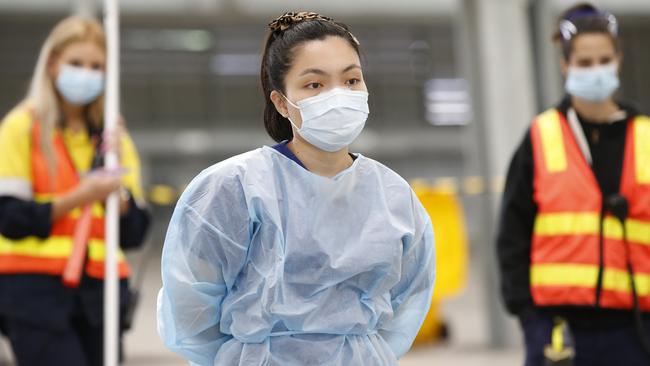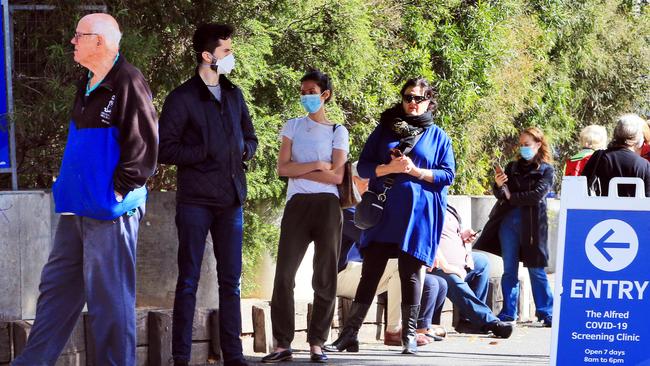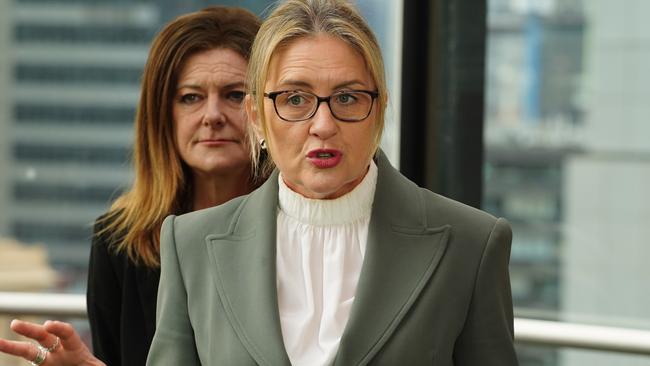More Covid deaths, hospitalisations now than when Vic locked down: How tune changed on killer virus
Hundreds more Victorians are in hospital with Covid – and many more are dying – than when Dan Andrews ordered a lockdown. Is “letting it rip” working, or do we need mask mandates?
Victoria
Don't miss out on the headlines from Victoria. Followed categories will be added to My News.
Hundreds more Victorians are being hospitalised, and many more dying, from Covid now than when the state was plunged into its sixth lockdown, leading some to question if the “let it rip” approach is the right one, or if the government has dropped the ball on public health with its all, then nothing, approach.
It comes as vaccination booster rates across the state plummet, new mutations emerge, immunity to past infection wanes and few Victorians opt to wear masks in public, ahead of the busiest social period of the year.
Unlike Western Australia — which brings back mask mandates in public hospitals on Monday, with far fewer Covid hospitalisations and deaths than Victoria — the Victorian Department of Health appears unlikely to enforce masks and reluctant even to enter into a public debate about the merits or otherwise of mandatory face coverings in some settings.
That’s despite a Melbourne University study — led by epidemiologist Prof Tony Blakely — showing permanently wearing masks in public would reduce Covid mortality rates by 25 per cent over 12 months.

The Victorian government no longer even has a true picture of the number of current Covid cases in the state, with people barred from reporting their positive RAT results to the Department of Health months ago.
The number of Covid cases throughout Victoria is therefore unknown, but could reasonably be expected to be much, much higher than WA’s 531 in the week ending November 12.
Victoria has by far the highest number of Covid outbreaks in nursing homes of any state; with mask wearing ad hoc across most, and not worn at all in some.
The latest Australian Department of Health and Aged Care Covid data, updated on November 16, shows there are currently a horror 643 Covid cases among Victorian nursing home residents, 204 cases in staff and outbreaks in 106 facilities. It also shows just 40.2 per cent of Victorian aged care residents have received a booster jab in the last six months.
And last week, a daily average of 317 Victorians were hospitalised with Covid — 14 in intensive care — and deaths across the state continued to rise, with 126 in the most recent 28-day reporting period. The WA mask mandate was triggered with 57 hospital admissions, four people in intensive care and four deaths of elderly citizens over the course of a week.
Recent Vic Covid deaths, hospitalisation rates
Week to Nov 17: 317 a day hospitalised, 126 deaths
Week to Nov 10: 321 a day hospitalised, 122 deaths
Week to Nov 3: 270 hospitalised, 109 deaths.
Week to 27 October: 233 hospitalised, 96 deaths
Week to 20 October: 179 hospitalised, 86 deaths
*Hospitalisations recorded by average number a day, deaths recorded over the Department of Health’s most recent 28-day reporting period
New strains circulating
The Victorian Department of Health also on Friday advised a new strain of Covid called Pirola — described as the most deadly since the first Omicron mutation — had recently been detected in the state’s wastewater, while the Omicron XBB variant EG.5 was still circulating. Another variant called HK. 3 is also rising rapidly.
Pirola and EG.5 are also in WA.
Govt people can manage Covid themselves
A Department of Health spokesman told the Herald Sun on Saturday: “Health services are following an operational staged response that has been in place for more than a year and has worked well in assisting hospitals respond to periods of increasing Covid-19 cases.
“Since last June, we have had a roadmap for our services that guide our hospital response, developed with hospitals and public health officials. In public settings, face masks and meeting in outdoor, well-ventilated areas can make a big difference and are particularly important when there’s increased transmission in the community, as is the case now.”
The department failed to answer a direct question from the Herald Sun about whether the government was concerned about the recent rise in deaths and hospitalisations throughout Victoria.
But in a statement said: “The vast majority of Victorians with Covid are experiencing only minor symptoms and can largely self-manage their care, with some escalating their care needs to their regular GP or the National Coronavirus Helpline managed by the Commonwealth”.
It added the government had observed a rise in vaccinations recently, and it was important those eligible or at greater risk of becoming very unwell with Covid got a 2023 booster, and accessed antivirals if and when they got sick.
“If you were recommended to have a 2023 booster earlier in the year and haven’t had one, then you should get one as soon as possible. If you test positive for Covid-19, it is recommended that you should isolate for at least five days and until you don’t have symptoms anymore. You should not work or visit a high risk setting like hospitals, aged care and disability services where there are people who are at a higher risk of becoming very sick,” the health department said in its official response to the Herald Sun.
The state’s healthcare system was quietly moved to a “stage two operational response” in early November amid the surge in Covid cases, allowing individual health facilities the ability to enforce masks if they wish.
Unlike WA, it is not a statewide, mandatory directive.
‘Covid cases are rising again’
Top Melbourne doctor and past AMA vice president Stephen Parnis advised Victorians on Twitter last week to mask up in higher-risk settings and stay home when unwell, adding masks continued to be worn by health professionals in hospitals, even if not mandated.
“Numbers of Covid cases are rising again, with some of them needing hospital care,” Dr Parnis said.
“Too many people still die from Covid, or are debilitated by long Covid, but a sensible approach reduces the risk.”
Asked this month in a podcast titled Is the COVID-19 pandemic over? if the “just let this thing rip” approach had been the right one when all Victorian Covid restrictions were removed, infectious diseases expert and director of Melbourne’s Doherty Institute, Professor Sharon Lewin, said it was hard to say retrospectively.
“There were things that perhaps we could have done differently (but) it’s important to remember that by the end of 2021 there was huge fatigue,” she said, adding most of the population had been vaccinated and it was thought at the time the dominant variant circulating was milder than original strains.
‘For the elderly it‘s still a big issue’
“The pandemic as a public health emergency I think is over,” Prof Lewin said. “But Covid is not over. It’s now an endemic infection that we will never get rid of … I think the big focus now should be on people at risk of severe disease. For immunosuppressed people Covid remains a very, very big problem … and for the elderly it still remains a big issue, and then of course the issue of long Covid, and repeated infections and what that means for your risk of long Covid.”
Prof Lewin said there was “absolutely no question” it was right for the state to remain open, and free of harsh Covid restrictions.
“But I think it’s incredibly important that we take an objective look at what happened and how we might do things differently, what the gaps were and where investments should be made going forward,” she said.
“I think the most important thing is not a point and blame game — that’s not going to help anyone. We’re dealing with the unknown and I would love to see the focus on practical solutions.”
Covid now compared to lockdown days
The Victorian Covid hospitalisation rate of 317 a day compares to just seven coronavirus cases in hospital on August 5, 2021, when then premier Daniel Andrews announced another lockdown, declaring: “The Delta variant moves faster than anything our public health experts have seen before — we know what we need to do to drive it down once again”.

There were just five reasons to leave the house from 8pm on August 5, 2021 — getting food, exercising for up to two hours, care-giving, authorised work or education if it couldn’t be performed from home, or to get vaccinated at the nearest possible location.
Shopping and exercise had to be done within 5km of the home and wearing face masks in public was mandatory.
Private gatherings were not permitted “except for an intimate partner” visit, and exercise was limited to two people. Schools, again, were closed.
There are more Victorians hospitalised now also than at about the same time last year, with 274 people in hospital and eight in intensive care, on November 11 last year.
There are more now also than at the same time two years’ ago, when 284 Victorians were hospitalised on November 24, 2021. There were three deaths then, of people aged in their 60s, 70s and 90s.
At the same time three years’ ago, on November 23, 2020, just one person was hospitalised in metropolitan Melbourne, and the state was celebrating its 24th straight day of zero daily new cases — better known as doughnut days.
Despite the lack of cases, restrictions then included mandatory face masks in public, working from home, public gatherings being restricted to 10 people outdoors and households being allowed to receive just two adult visitors per day.
Restaurants and bars were only allowed 40 patrons per venue inside and 70 outside — and social distancing was enforced everywhere.
Weddings, including receptions, were allowed 10 guests and indoor funerals just 20 mourners.

Head of Melbourne’s Burnet Institute Professor Brendan Crabb this month said that in 2023, Covid would result in about 1000 deaths nationally each month — “five per cent more deaths than what we usually have”.
And it was likely that number was actually higher because while many of the deaths would be directly attributed to Covid, some would not be because the infection that ultimately proved fatal had occurred months earlier.
“We must find the will to do better”
Last week on Twitter, Prof Crabb said: “We simply must find the will to do better. And what’s required is not that onerous, we have the knowledge and tools that can be applied and better ones on the way”.
In an article in the West Australian this month, he said he had “no problem with declaring the end of an emergency … but (Covid) is obviously still an exceptional disease, not a garden-variety cold, and needs an exceptional response.”
Infectious diseases researcher Prof Crabb is also chair of the Australian Global Health Alliance and chair of Pacific Friends of Global Health.
Fears are also growing in Victorian medical and scientific communities about the increasing public health burden of long Covid and other serious, and even deadly post-Covid health problems.
University of New South Wales experts said this month “case numbers and indicators of severe disease began rising in Victoria in August”.
“Now we see evidence of this new wave via wastewater surveillance for traces of SARS-CoV-2, the virus that causes Covid. We also see rises in Covid-related hospital admissions and antiviral prescriptions. Compared to past waves, this one has built up slowly and over a longer period,” James Wood, Bette Liu, Katie Louise Flanagan and Stuart Turville said on November 13.

“We’re seeing the result of a constantly mutating virus. Successful SARS-CoV-2 variants are gradually acquiring mutations. Some of these changes reduce the ability of existing antibodies to bind to and neutralise the virus. So it appears it’s still the ‘immune escape’ variants that are behind these latest waves.”
Pirola may be dangerous in 2024
The BA. 2.86 mutation – colloquially known as Pirola – had not been influential so far in the current Covid wave “but it has continued to evolve, and we may see it play a much bigger role in Australia in 2024”, they warned.
Earlier this month a leading doctor warned Victorian emergency departments were “running on less staff than in 2020”.
Health system “incredibly stretched”
Australian Medical Association Victoria vice president Dr Simon Judkins, who works in regional and metropolitan emergency departments, said the health system was “incredibly stretched” at the moment.
“The shortfalls in staff across many of our emergency departments is quite profound,” he said.
“Most emergency departments are really struggling to actually have staff on the ground.
“In fact, we’re running many EDs on lesser staff than we had back in 2020.”

He said he knew the community was tired of Covid, but warned rising cases were “another unwanted pressure” on top of GP shortages, increasing mental health demands and difficulties discharging elderly hospital patients into aged care.
“A lot of our hospitals are really suffering at the moment from a high level of worker fatigue, burn out, a lot of sick leave,” he said.
“Presentations are increasing, length of stay in a lot of emergency departments is increasing because the hospital system’s full and then you bring into that already stretched system an increase in Covid presentations.”
More Coverage
Originally published as More Covid deaths, hospitalisations now than when Vic locked down: How tune changed on killer virus




